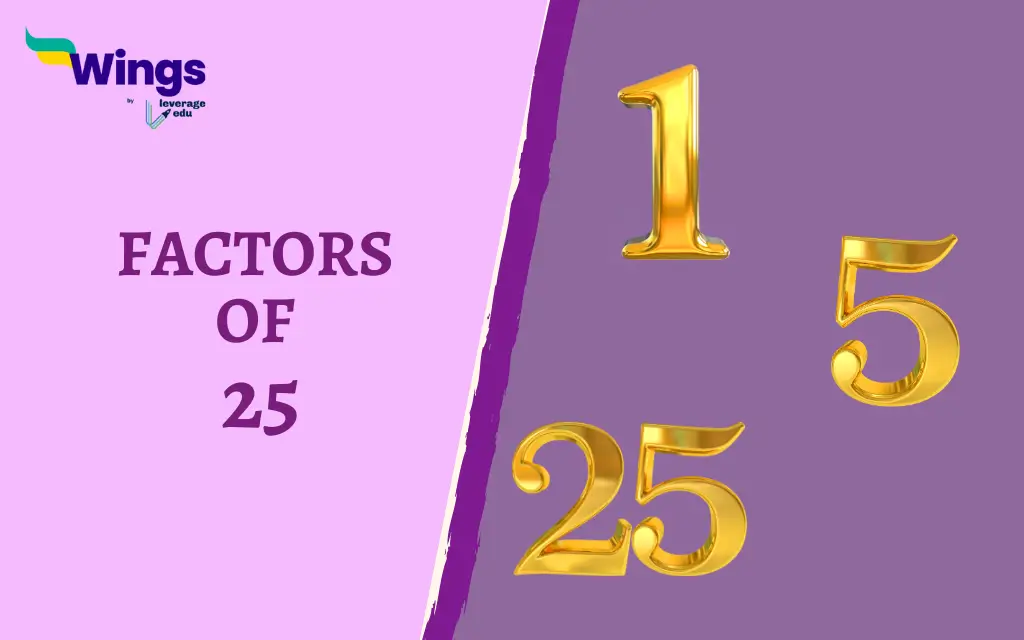Have you ever wondered how many ways you can divide a number into equal parts with no remainders? Factors of 25 are generally used in mathematics to find dimensions of squares, calculate area, and determine multiples in diverse contexts such as finance, timekeeping, and engineering. Read on to learn more about the Factors of 25, by division method, via HCF, their factor pairs and more!
Also Read: All You Need to Know About HCF and LCM
What are the Factors of 25?
In simpler terms, factors of a number are all the positive integers (including 1 and itself) that divide evenly into that number. Moreover, whilst dividing when there is no remainder, hence the divisor is a factor of the dividend. So, what are the Factors?
- 1 (One divides evenly into any number)
- 5 (25 divided by 5 equals 5 with no remainder)
- 25 (The number itself is always considered a factor)
Therefore, 1, 5, and 25 are the factors of 25. However, it is important to note that factors can also have negative integers as long as the division results in a whole number. In this case, the negative factors would be -1, -5, and -25.
Also Read: Algebraic Identities: Examples and Chart
Factors of 25 by Division Method
Additionally, finding factors can be done through a simple division method. Here is how you can identify the factors using division:
- Begin with 1. As 1 divides evenly into any number, it will always be a factor.
- Check for divisibility by consecutive positive integers (which are 2, 3, 4, etc.). In this case, 2 cannot be divided evenly into 25 (25 divided by 2 leaves a remainder of 1). Thus, 2 is not a factor of 25.
- Next, check with the next integer, 3. Again, 3 cannot be divided into 25 purely.
- You reach the number 5. Now, dividing 25 by 5 gives us 5 with no remainder. Therefore, 5 is a Factor.
- Since you have found a factor (5), you can also explore if 5 itself has factors that divide 25. Dividing 25 by 5 again gives us 5, confirming that 25 itself is also a factor.
Therefore, following this method, you arrive at the same conclusion that 1, 5, and 25 are the Factors.
Also Read: 10 Properties of Determinants: Formulas and Examples
What are the Factors in HCF?
HCF is the Highest Common Factor and is the largest number that is a factor of two or more given numbers. Furthermore, since 25 has only three factors (1, 5, and 25), the HCF of 25 and itself (or any number for that matter) will always be the largest factor, which is 25.
Also Read: What is the HCF of Two Consecutive Numbers?
What are Factor Pairs for 25?
Factor pairs are two numbers that are multiplied together, hence resulting in the original number. In the case of 25, there are three factors: 1, 5, and 25. Moreover, here are the corresponding factor pairs for 25:
- 1 x 25
- 5 x 5
As you can see, each pair multiplies to give us 25.
Also Read: Cross-Sectional Area of Different Shapes with Formula
What are the Multiples of Factors of 25?
Multiples of a number are all the numbers that you can get by multiplying the number by any whole number (which also includes 0). So, what are the multiples of the Factors of 25?
- Multiples of 1: As 1 is multiplied by any number and results in the same number, all positive and negative integers are technically multiples of 1.
- Multiples of 5: Here, the multiples would be 5, 10, 15, 20, 25, and so on. In addition, any integer divisible by 5 is a multiple of 5.
- Multiples of 25: Since 25 itself is a number, its multiples would include 25, 50, 75, 100, and so on. Any integer divisible by 25 is considered a multiple of 25.
Related Blogs
I hope this helps! Did you like learning about the Factors of 25? Keep reading our blogs to learn more about the Basic Concepts of Maths!
 One app for all your study abroad needs
One app for all your study abroad needs














